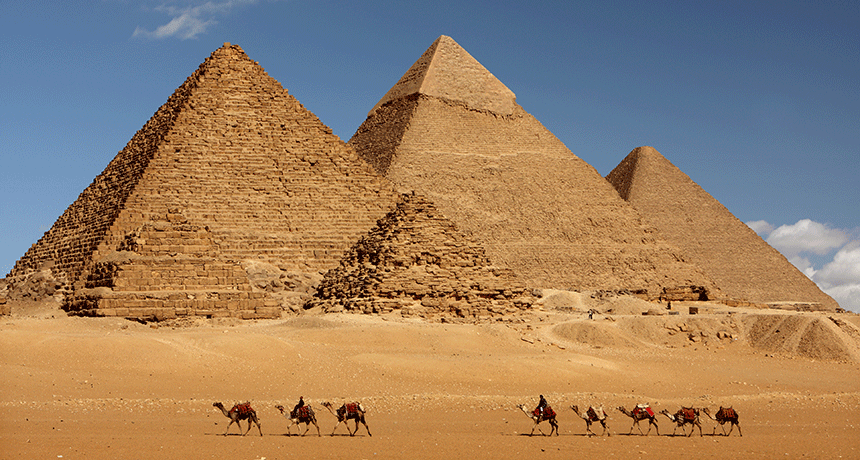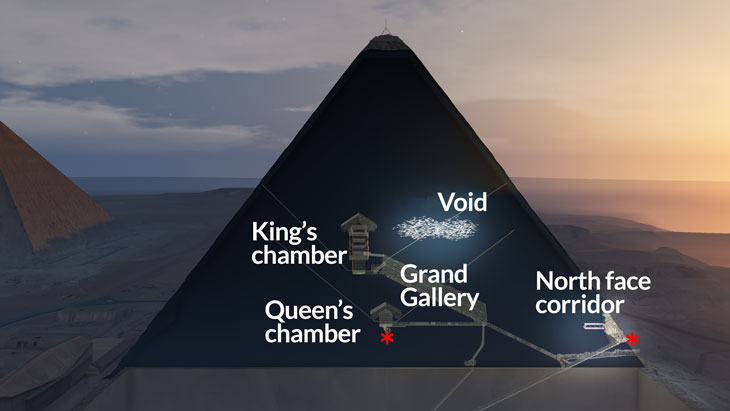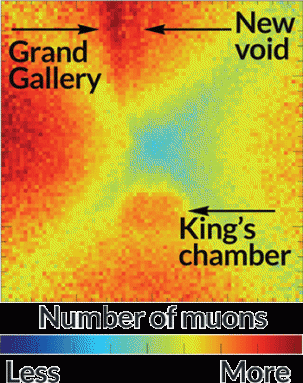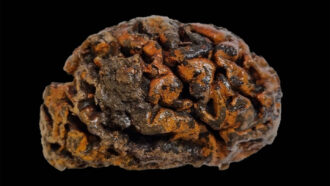Scientists detect mystery void in Great Pyramid of Giza
Particles from space point to unknown chamber in the 4,500-year-old Egyptian monument

The Great Pyramid of Giza, the largest of the Egyptian pyramids and the last remaining ancient wonder of the world, contains a large, previously undiscovered void, researchers now report.
Sculples/istockphoto
Particles from outer space have helped uncover a mysterious void deep inside the Great Pyramid of Giza, the largest pyramid in Egypt.
Researchers made the discovery using high-tech devices that typically are used only for experiments in particle physics. (That’s the study of particles smaller than atoms.) The detectors scouted for particles streaming from outer space through the ancient structure’s thick stone. This search turned up a previously unknown empty space, or void. That unknown chamber is the first major structure discovered inside the roughly 4,500-year-old Great Pyramid since the 19th century.
The team described its new find online November 2 in Nature.
Peter Der Manuelian is an expert on ancient Egypt at Harvard University in Cambridge, Mass. Although he was not involved in the work, he says the newfound void is “a significant discovery.” Precisely what it means, however, is still not clear, he adds.
The Great Pyramid is the only one of the ancient Seven Wonders of the World that still stands. It was built as a burial tomb for Pharaoh Khufu (FAIR-oh KOO-foo). The newfound void may make up one or more rooms or corridors in the pyramid. But the researchers can’t tell yet, for sure. Why? The particle detectors revealed only the rough size of the void, not details of its shape. Learning more about the pyramid’s architecture could offer new insights into one of the world’s largest, oldest and most famous monuments.
“Imagine you’re an archaeologist and you walk into this room no one has walked in for [more than] 4,000 years,” says Nural Akchurin. He’s a physicist at Texas Tech University in Lubbock who wasn’t involved in the study. “That’s huge,” he says — “incredible!”
Subatomic particles provide clues
Researchers probed the inside of the Great Pyramid using devices that sense muons. These are particles smaller than atoms. That’s why they’re called subatomic particles. Muons are by-products of spacefaring particles called cosmic rays. When cosmic rays strike atoms in the Earth’s atmosphere, they form muons. Those muons then rain nonstop onto Earth at nearly the speed of light. They streak easily through open air. Rock, however, can absorb or deflect them.
Story continues below image.

That made them a handy tool for researchers who wanted to learn more about what lies inside the Great Pyramid. The scientists placed muon detectors near the base of the structure and in areas deep within it. Then they counted the number of muons that reached the detectors from different directions. By comparing the different results, they could spot empty spaces inside the ancient pyramid.
For instance, imagine a detector inside the pyramid picked up slightly more muons from the north than the south. That would suggest there was slightly less rock on the north side to intercept the incoming muons. And this would hint at an empty space in that direction.
Using muons to image a huge, dense structure like the Great Pyramid “is not an easy game,” Akchurin notes. The monument’s rock filters out 99 percent of incoming muons before they reach detectors. So collecting enough data to spot any hollow spaces took months.

The first type of detector was a highly sensitive film. The researchers laid some of the film out in a space inside the pyramid called the Queen’s chamber. They put more of it in the corridor next to the chamber. As muons zipped through it, they produced a chemical reaction that created silver trails. Those trails revealed which direction the particles had come from.
A surprisingly large number of muons came through a region above the Grand Gallery. This sloping corridor runs through the center of the pyramid, from north to south. The newfound cavity appears to be at least 30 meters (about 98 feet) across. That’s about the size of the Grand Gallery itself.
“Our first reaction was a lot of excitement,” says Mehdi Tayoubi. He is one of the study’s authors, and a cofounder of the Heritage Innovation Preservation Institute in Paris. “We said: ‘Wow! We got something big.’”
Tayoubi’s team confirmed its discovery with observations from two other types of muon detectors. They generate electrical signals as muons pass through them. The researchers had placed them inside the Queen’s chamber and outside at the base of the pyramid.
Akchurin hopes his group’s finding will pave the way for muon imaging of other ancient monuments around the world. Such work could be particularly valuable at archaeological sites where traditional excavation may be difficult, such as deep in the jungle or on mountainsides.







